A Green Voltammetric Determination of Molnupiravir Using a Disposable Screen-Printed Reduced Graphene Oxide Electrode: Application for Pharmaceutical Dosage and Biological Fluid Forms
Abstract
:1. Introduction
2. Materials and Methods
2.1. Chemicals and Reagents
2.2. Apparatus
2.3. Fabrication of Working Electrodes
2.4. Preparation of Working Standard Solution
2.5. Method Optimization
2.6. General Procedure
2.7. Sample Preparation
2.7.1. Preparation of Pharmaceutical Dosage Form
2.7.2. Spiked Urine Analysis
2.7.3. Spiked Serum Analysis
3. Results and Discussion
3.1. Characterization of the Electrode
3.1.1. Structural and Surface Morphology of Working Electrodes
3.1.2. Electro-Characterization of the Working Electrode
3.1.3. Optimization of pH Using the rGO-SPCE
3.1.4. Effect of Scan Rate
3.1.5. Proposed Oxidation Mechanism of MOV Using the rGO-SPCE 2.5%
3.1.6. Effect of Surfactant Concentration
3.2. Method Validation
3.2.1. Linearity, Limit of Detection, and Limit of Quantification
3.2.2. Precision
3.2.3. Specificity
3.2.4. Robustness
3.3. Applications
3.3.1. Pharmaceutical Dosage Form
3.3.2. Human Biofluids
3.4. Stability of the Modified Electrode
3.5. Assessment of the Greenness Profile
3.6. The Features of the Developed Methodology Based on rGO-SPCE in Terms of Performance and Economic Perspective
4. Conclusions
Supplementary Materials
Author Contributions
Funding
Institutional Review Board Statement
Informed Consent Statement
Data Availability Statement
Conflicts of Interest
References
- Mohan, B.; Vinod, N. COVID-19: An Insight into SARS-CoV-2 Pandemic Originated at Wuhan City in Hubei Province of China. J. Infect. Dis. Epidemiol. 2020, 6, 146. [Google Scholar] [CrossRef]
- Abdelazim, A.H.; Abourehab, M.A.S.; Abd Elhalim, L.M.; Almrasy, A.A.; Ramzy, S. Green Adherent Spectrophotometric Determination of Molnupiravir Based on Computational Calculations; Application to a Recently FDA-Approved Pharmaceutical Dosage Form. Spectrochim. Acta Part A Mol. Biomol. Spectrosc. 2023, 285, 121911. [Google Scholar] [CrossRef]
- Mohamed, A.R.; Abolmagd, E.; Nour, I.M.; Badrawy, M.; Hasan, M.A. Earth-Friendly-Assessed Silver-Nanoparticles Spectrophotometric Method for Rapid and Sensitive Analysis of Molnupiravir, an FDA-Approved Candidate for COVID-19: Application on Pharmaceutical Formulation and Dissolution Test. BMC Chem. 2023, 17, 13. [Google Scholar] [CrossRef] [PubMed]
- Salman, B.I.; Hara, M.A.; El Deeb, S.; Ibrahim, A.E.; Saraya, R.E.; Ali, M.F.B. Zinc(II) Complexation Strategy for Ultra-Sensitive Fluorimetric Estimation of Molnupiravir: Applications and Greenness Evaluation. Arch. Pharm. 2023, 356, e2300005. [Google Scholar] [CrossRef] [PubMed]
- Sharaf, Y.A.; El Deeb, S.; Ibrahim, A.E.; Al-Harrasi, A.; Sayed, R.A. Two Green Micellar HPLC and Mathematically Assisted UV Spectroscopic Methods for the Simultaneous Determination of Molnupiravir and Favipiravir as a Novel Combined COVID-19 Antiviral Regimen. Molecules 2022, 27, 2330. [Google Scholar] [CrossRef] [PubMed]
- Reçber, T.; Timur, S.S.; Kablan, S.E.; Yalçın, F.; Karabulut, T.C.; Gürsoy, R.N.; Eroğlu, H.; Kır, S.; Nemutlu, E. A Stability Indicating RP-HPLC Method for Determination of the COVID-19 Drug Molnupiravir Applied Using Nanoformulations in Permeability Studies. J. Pharm. Biomed. Anal. 2022, 214, 114693. [Google Scholar] [CrossRef]
- Saraya, R.E.; ElDeeb, S.; Salman, B.I.; Ibrahim, A.E. Highly Sensitive High-Performance Thin-Layer Chromatography Method for the Simultaneous Determination of Molnupiravir, Favipiravir, and Ritonavir in Pure Forms and Pharmaceutical Formulations. J. Sep. Sci. 2022, 45, 2582–2590. [Google Scholar] [CrossRef]
- Amara, A.; Penchala, S.D.; Else, L.; Hale, C.; FitzGerald, R.; Walker, L.; Lyons, R.; Fletcher, T.; Khoo, S. The Development and Validation of a Novel LC-MS/MS Method for the Simultaneous Quantification of Molnupiravir and Its Metabolite ß-d-N4-Hydroxycytidine in Human Plasma and Saliva. J. Pharm. Biomed. Anal. 2021, 206, 114356. [Google Scholar] [CrossRef]
- Parsons, T.L.; Kryszak, L.A.; Marzinke, M.A. Development and Validation of Assays for the Quantification of β-D-N4-Hydroxycytidine in Human Plasma and β-D-N4-Hydroxycytidine-Triphosphate in Peripheral Blood Mononuclear Cell Lysates. J. Chromatogr. B Anal. Technol. Biomed. Life Sci. 2021, 1182, 122921. [Google Scholar] [CrossRef]
- Gupta, V.K.; Karimi-Maleh, H.; Sadegh, R. Simultaneous Determination of Hydroxylamine, Phenol and Sulfite in Water and Waste Water Samples Using a Voltammetric Nanosensor. Int. J. Electrochem. Sci. 2015, 10, 303–316. [Google Scholar] [CrossRef]
- Kablan, S.E.; Reçber, T.; Tezel, G.; Timur, S.S.; Karabulut, C.; Karabulut, T.C.; Eroğlu, H.; Kır, S.; Nemutlu, E. Voltammetric Sensor for COVID-19 Drug Molnupiravir on Modified Glassy Carbon Electrode with Electrochemically Reduced Graphene Oxide. J. Electroanal. Chem. 2022, 920, 116579. [Google Scholar] [CrossRef]
- Vural, K.; Karakaya, S.; Dilgin, D.G.; Gökçel, H.İ.; Dilgin, Y. Voltammetric Determination of Molnupiravir Used in Treatment of the COVID-19 at Magnetite Nanoparticle Modified Carbon Paste Electrode. Microchem. J. 2023, 184, 108195. [Google Scholar] [CrossRef] [PubMed]
- Erk, N.; Bouali, W.; Mehmandoust, M.; Soylak, M. An Electrochemical Sensor for Molnupiravir Based on a Metal-Organic Framework Composited with Poly(3,4-Ethylene Dioxythiophene): Poly(Styrene Sulfonate). ChemistrySelect 2022, 7, e202203325. [Google Scholar] [CrossRef]
- Li, M.; Li, Y.T.; Li, D.W.; Long, Y.T. Recent Developments and Applications of Screen-Printed Electrodes in Environmental Assays—A Review. Anal. Chim. Acta 2012, 734, 31–44. [Google Scholar] [CrossRef] [PubMed]
- Antuña-Jiménez, D.; González-García, M.B.; Hernández-Santos, D.; Fanjul-Bolado, P. Screen-Printed Electrodes Modified with Metal Nanoparticles for Small Molecule Sensing. Biosensors 2020, 10, 9. [Google Scholar] [CrossRef] [PubMed]
- Pereira, D.F.; Santana, E.R.; Spinelli, A. Electrochemical paper-based analytical devices containing magnetite nanoparticles for the determination of vitamins B2 and B6. Microchem. J. 2022, 179, 107588. [Google Scholar] [CrossRef]
- Torres-Rivero, K.; Torralba-Cadena, L.; Espriu-Gascon, A.; Casas, I.; Bastos-Arrieta, J.; Florido, A. Strategies for Surface Modification with Ag-Shaped Nanoparticles: Electrocatalytic Enhancement of Screen-Printed Electrodes for the Detection of Heavy Metals. Sensors 2019, 19, 4249. [Google Scholar] [CrossRef]
- Meier, J.; Schiøtz, J.; Liu, P.; Nørskov, J.K.; Stimming, U. Nano-Scale Effects in Electrochemistry. Chem. Phys. Lett. 2004, 390, 440–444. [Google Scholar] [CrossRef]
- Li, C.M.; Hu, W. Electroanalysis in Micro- and Nano-Scales. J. Electroanal. Chem. 2013, 688, 20–31. [Google Scholar] [CrossRef]
- Jirasirichote, A.; Punrat, E.; Suea-Ngam, A.; Chailapakul, O.; Chuanuwatanakul, S. Voltammetric Detection of Carbofuran Determination Using Screen-Printed Carbon Electrodes Modified with Gold Nanoparticles and Graphene Oxide. Talanta 2017, 175, 331–337. [Google Scholar] [CrossRef]
- Fernández, C.M.; Martin, V.C. Preparation d’un Tampon Universel de Force Ionique 0.3 M. Talanta 1977, 24, 747–748. [Google Scholar] [CrossRef] [PubMed]
- Rizk, M.; Taha, E.A.; El-Alamin, M.M.A.; Hendawy, H.A.M.; Sayed, Y.M. Highly Sensitive Carbon Based Sensors Using Zinc Oxide Nanoparticles Immobilized Multiwalled Carbon Nanotubes for Simultaneous Determination of Desvenlafaxine Succinate and Clonazepam. J. Electrochem. Soc. 2018, 165, H333–H341. [Google Scholar] [CrossRef]
- Hendawy, H.A.M.; Salem, W.M.; Abd-Elmonem, M.S.; Khaled, E. Nanomaterial-Based Carbon Paste Electrodes for Voltammetric Determination of Naproxen in Presence of Its Degradation Products. J. Anal. Methods Chem. 2019, 2019, 5381031. [Google Scholar] [CrossRef]
- Jahani, P.M.; Beitollahi, H.; Tajik, S. Surface Amplification of Graphite Screen Printed Electrode Using Reduced Graphene Oxide/Polypyrrole Nanotubes Nanocomposite; a Powerful Electrochemical Strategy for Determination of Sulfite in Food Samples. Food Chem. Toxicol. 2022, 167, 113274. [Google Scholar] [CrossRef] [PubMed]
- Er, E. A Portable Electrochemical Platform Based on Graphene Nanosheets by Metal Intercalation Engineering for Anticancer Drug Pemetrexed Sensing. FlatChem 2022, 33, 100353. [Google Scholar] [CrossRef]
- Hasanpour, M.; Pardakhty, A.; Tajik, S. The Development of Disposable Electrochemical Sensor Based on MoSe2-RGO Nanocomposite Modified Screen Printed Carbon Electrode for Amitriptyline Determination in the Presence of Carbamazepine, Application in Biological and Water Samples. Chemosphere 2022, 308, 136336. [Google Scholar] [CrossRef]
- Barthasarathy, P.R.; Ahmed, N.A.; Salim, W.W.A.W. Reduced Graphene Oxide on Screen-Printed Carbon Electrodes as Biosensor for Escherichia Coli O157:H7 Detection. Proceedings 2020, 60, 13. [Google Scholar]
- Wu, Y.; Zhang, T.; Su, L.; Wu, X. Electrodeposited rGO/AuNP/MnO2 Nanocomposite-Modified Screen-Printed Carbon Electrode for Sensitive Electrochemical Sensing of Arsenic(III) in Water. Biosensors 2023, 13, 563. [Google Scholar] [CrossRef]
- Dinani, H.S.; Pourmadadi, M.; Yazdian, F.; Rashedi, H.; Ebrahimi, S.A.S.; Shayeh, J.S.; Ghorbani, M. Fabrication of Au/Fe3O4/RGO Based Aptasensor for Measurement of MiRNA-128, a Biomarker for Acute Lymphoblastic Leukemia (ALL). Eng. Life Sci. 2022, 22, 519–534. [Google Scholar] [CrossRef]
- Ngamchuea, K.; Eloul, S.; Tschulik, K.; Compton, R.G. Planar Diffusion to Macro Disc Electrodes—What Electrode Size Is Required for the Cottrell and Randles-Sevcik Equations to Apply Quantitatively? J. Solid State Electrochem. 2014, 18, 3251–3257. [Google Scholar] [CrossRef]
- Al Alamein, A.M.A.; Hendawy, H.A.M.; Elabd, N.O. Voltammetric Determination of Dicyclomine Hydrochloride by Carbon Paste Electrode Modified with Iron (III) Oxide Nanoparticles and Activated Glassy Carbon Electrode in Pharmaceutical Dosage Form, Human Plasma and Urine. Int. J. Electrochem. Sci. 2018, 13, 7989–8005. [Google Scholar] [CrossRef]
- Abdel Maksoud, M.I.A.; El-Sayyad, G.S.; Ashour, A.H.; El-Batal, A.I.; Abd-Elmonem, M.S.; Hendawy, H.A.M.; Abdel-Khalek, E.K.; Labib, S.; Abdeltwab, E.; El-Okr, M.M. Synthesis and Characterization of Metals-Substituted Cobalt Ferrite [Mx Co (1-x) Fe2O4; (M = Zn, Cu and Mn; x = 0 and 0.5)] Nanoparticles as Antimicrobial Agents and Sensors for Anagrelide Determination in Biological Samples. Mater. Sci. Eng. C Mater. Biol. Appl. 2018, 92, 644–656. [Google Scholar] [CrossRef] [PubMed]
- Hendawy, H.A.M.; Youssif, R.M.; Salama, N.N.; Fayed, A.S.; Salem, M.Y. Challenge Approach of an Inexpensive Electrochemical Sensor for Rapid Selective Determination of Two Non-Classical β-Lactams in Presence of Different Degradants and Interference Substances. Electroanalysis 2017, 29, 2708–2718. [Google Scholar] [CrossRef]
- Laviron, E. Surface Linear Potential Sweep Voltammetry. Equation of the Peaks for a Reversible Reaction When Interactions between the Adsorbed Molecules Are Taken into Account. J. Electroanal. Chem. 1974, 52, 395–402. [Google Scholar] [CrossRef]
- Fekry, A.M.; Shehata, M.; Azab, S.M.; Walcarius, A. Voltammetric Detection of Caffeine in Pharmacological and Beverages Samples Based on Simple Nano-Co (II, III) Oxide Modified Carbon Paste Electrode in Aqueous and Micellar Media. Sens. Actuators B Chem. 2020, 302, 127172. [Google Scholar] [CrossRef]
- Boltia, S.A.; Kandeel, N.H.; Hegazy, M.A.; Hendawy, H.A. Analytical Eco-Scale Determination of Vortioxetine using Advanced Electrochemical Platform for Screen-Printed Disposable Multi-Walled Carbon Nanotube Electrode in Presence of an Anionic Surfactant. New J. Chem. 2023, 47, 11015–11029. [Google Scholar] [CrossRef]
- International Conference on Harmonization (ICH: Q2). Guideline on Validation of Analytical Procedures: Text and Methodology; European Medicines Agency: Amsterdam, The Netherlands, 2005.
- Bindu, M.; Gandla, K.; Vemireddy, S.; Samuel, S.; Praharsha, Y. A Validated Stability Indicating RP-HPLC Method for the Determination of Molnupiravir in Pharmaceutical Dosage Form. World J. Adv. Res. Rev. 2022, 15, 580–590. [Google Scholar] [CrossRef]
- Lin, K.C.; Chen, S.M. Reversible Cyclic Voltammetry of the NADH/NAD+ Redox System on Hybrid Poly(Luminol)/FAD Film Modified Electrodes. J. Electroanal. Chem. 2006, 589, 52–59. [Google Scholar] [CrossRef]
- Soliman, S.S.; Sedik, G.A.; Elghobashy, M.R.; Zaazaa, H.E.; Saad, A.S. Greenness Assessment Profile of a QbD Screen-Printed Sensor for Real-Time Monitoring of Sodium Valproate. Microchem. J. 2022, 182, 107859. [Google Scholar] [CrossRef]
- El-Hanboushy, S.; Marzouk, H.M.; Fayez, Y.M.; Abdelkawy, M.; Lotfy, H.M. Sustainable spectrophotometric determination of antihypertensive medicines reducing COVID-19 risk via paired wavelength data processing technique-Assessment of purity, greenness and whiteness. Sustain. Chem. Pharm. 2022, 29, 100806. [Google Scholar] [CrossRef]

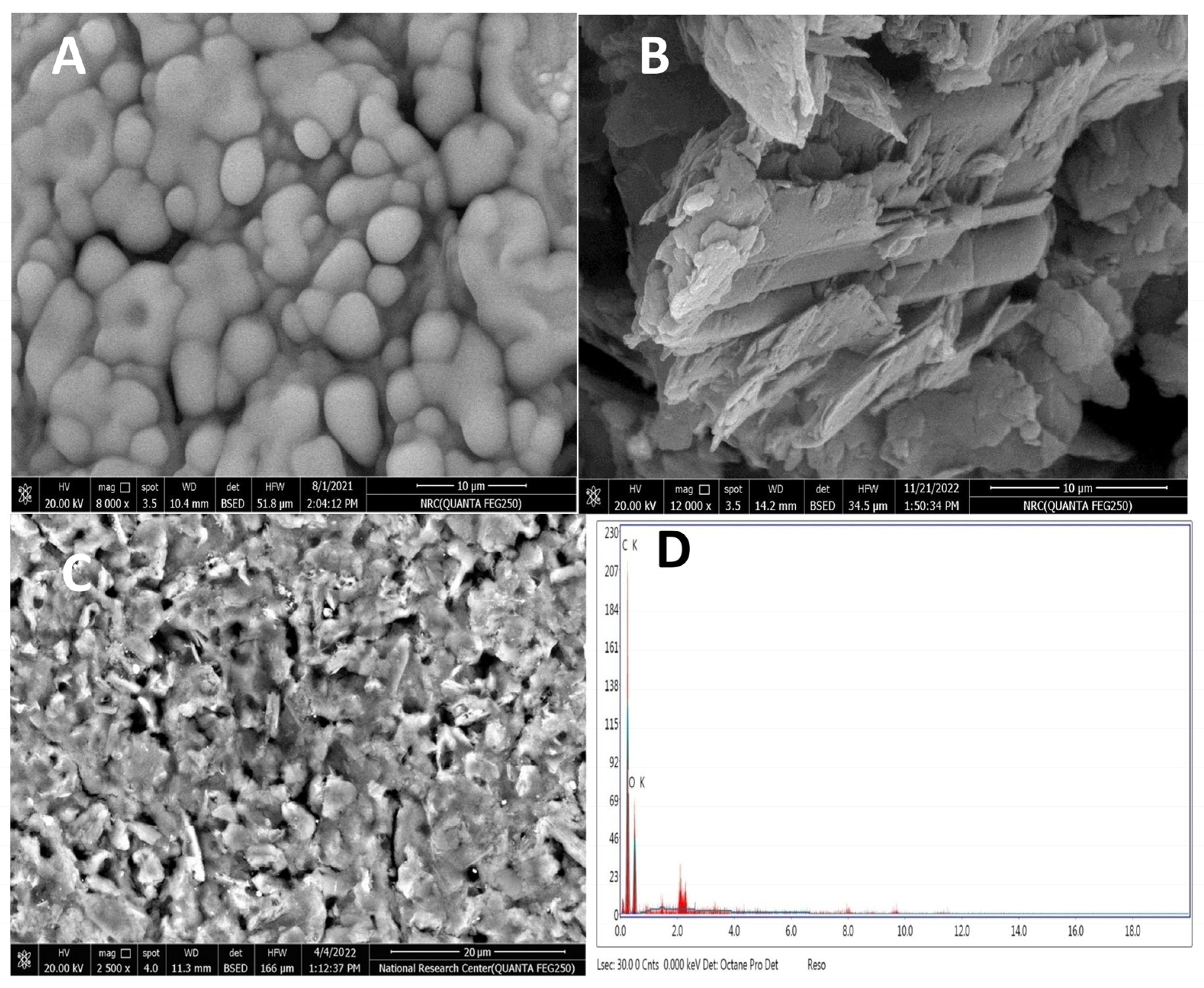
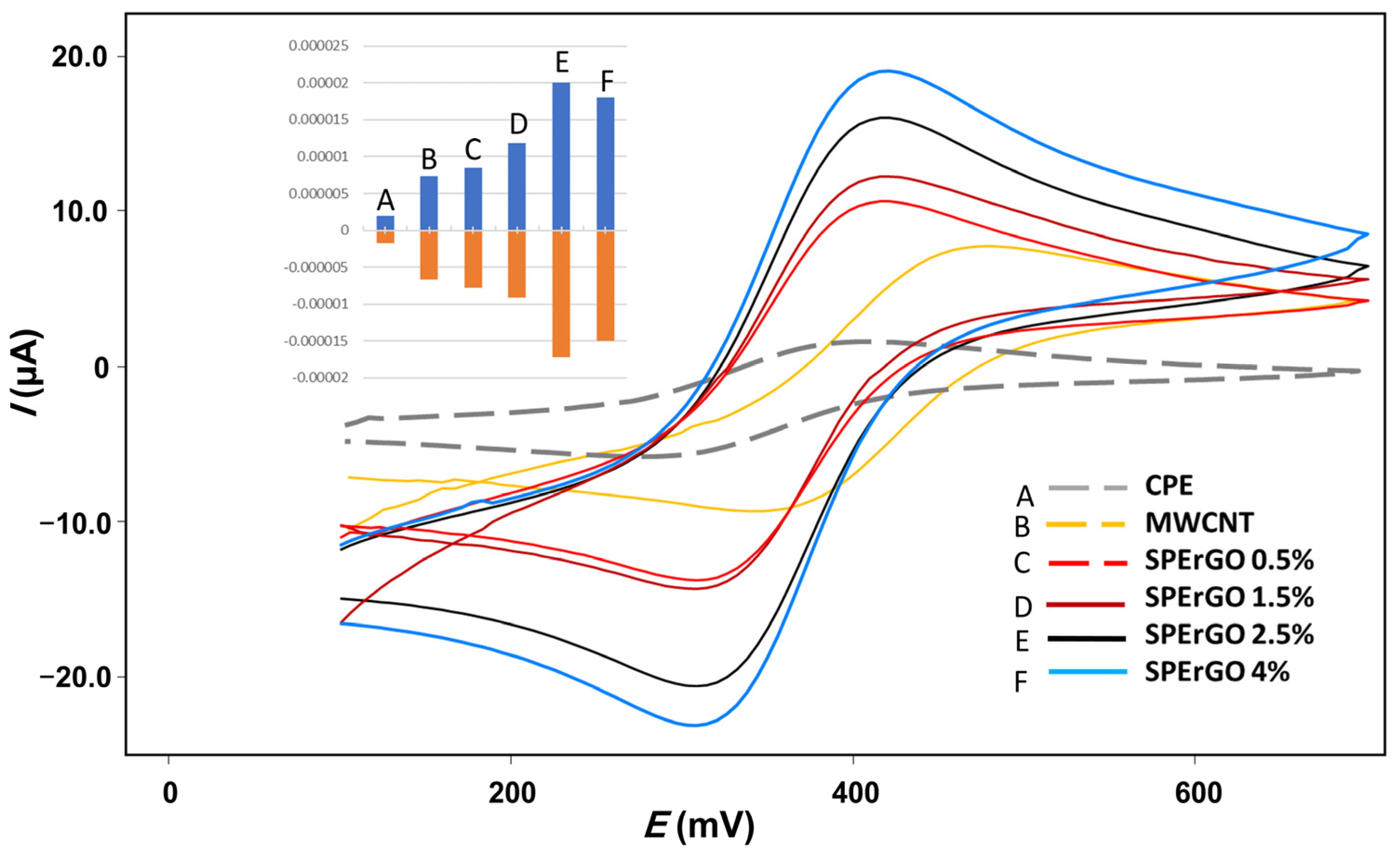
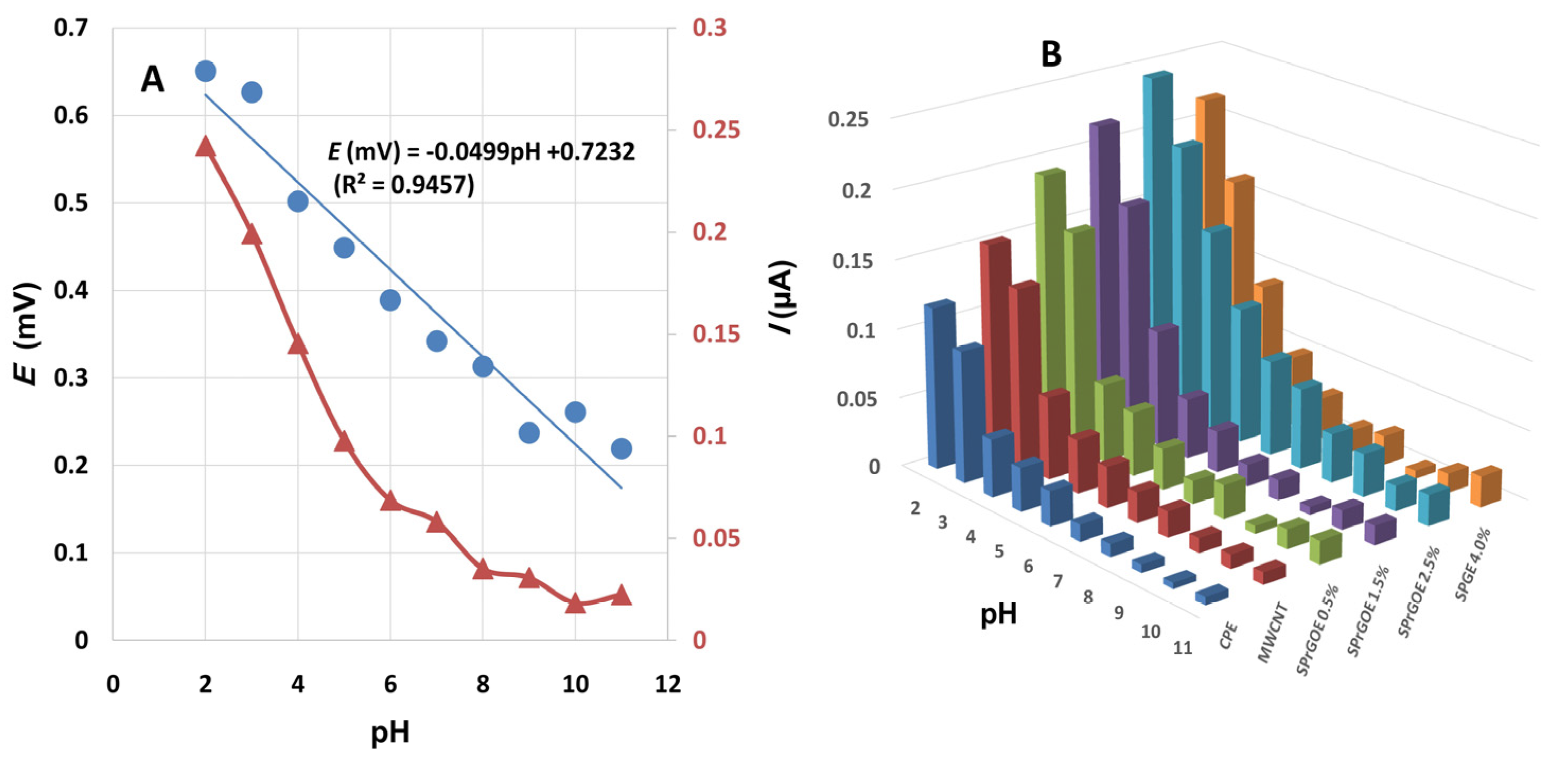
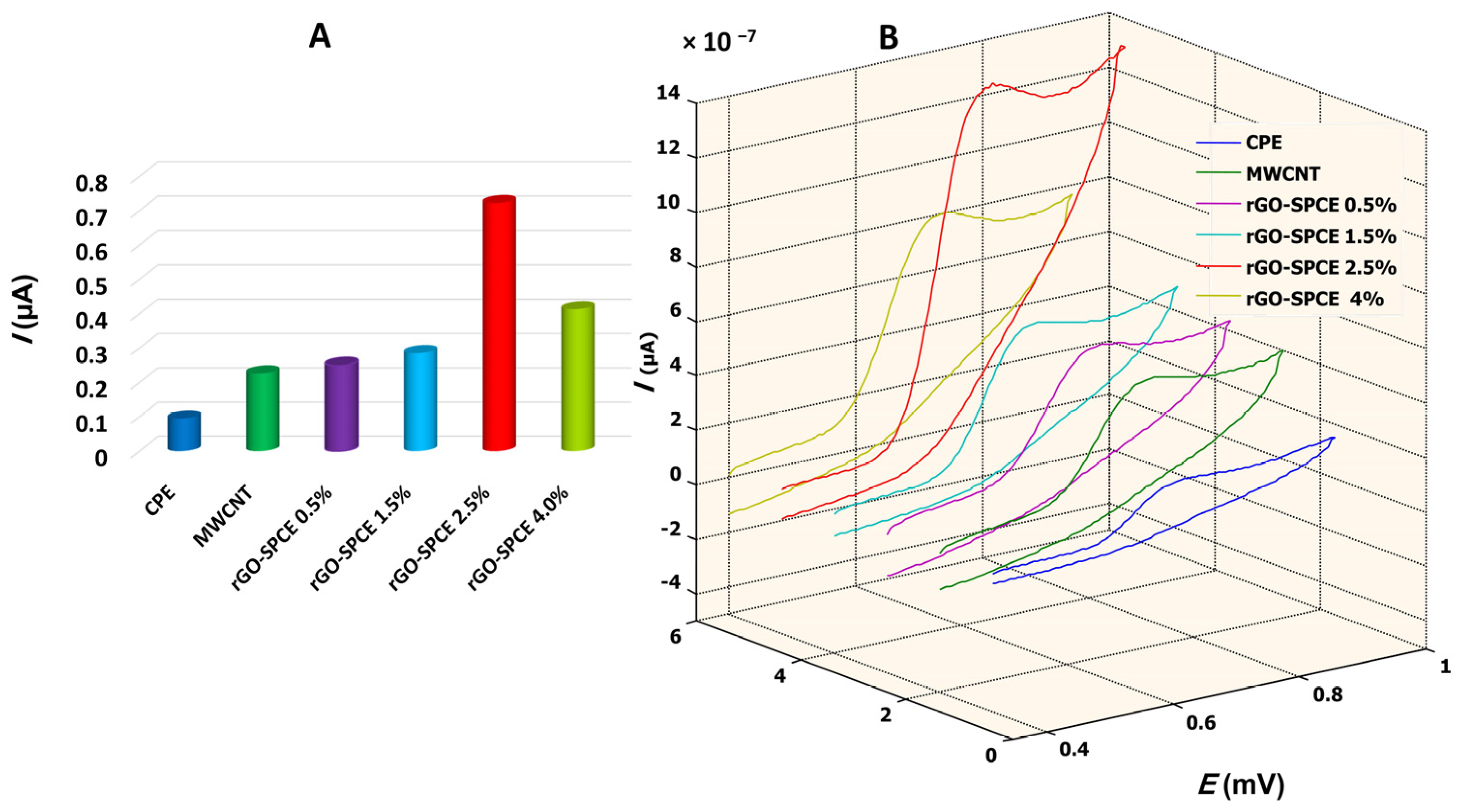
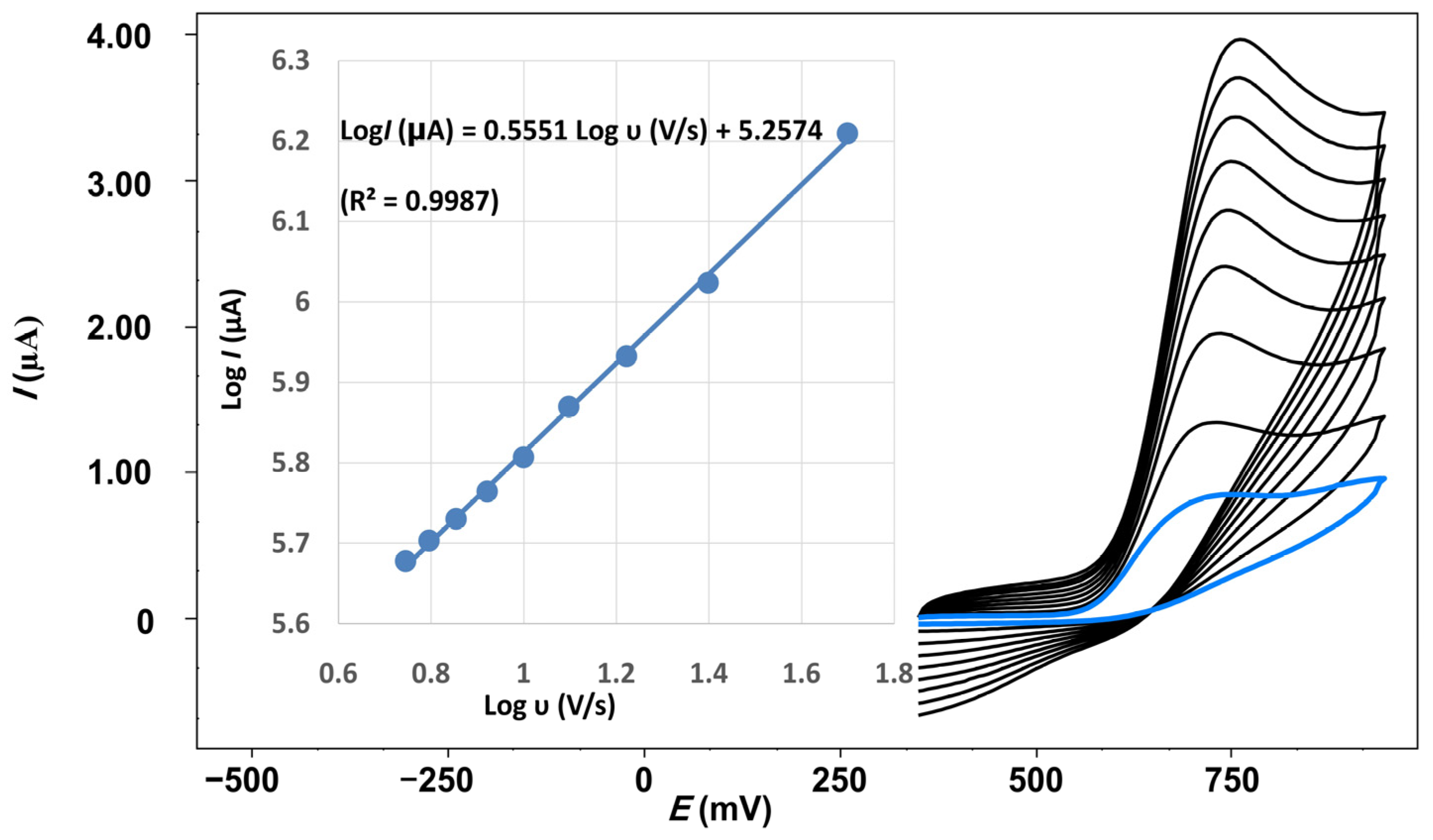
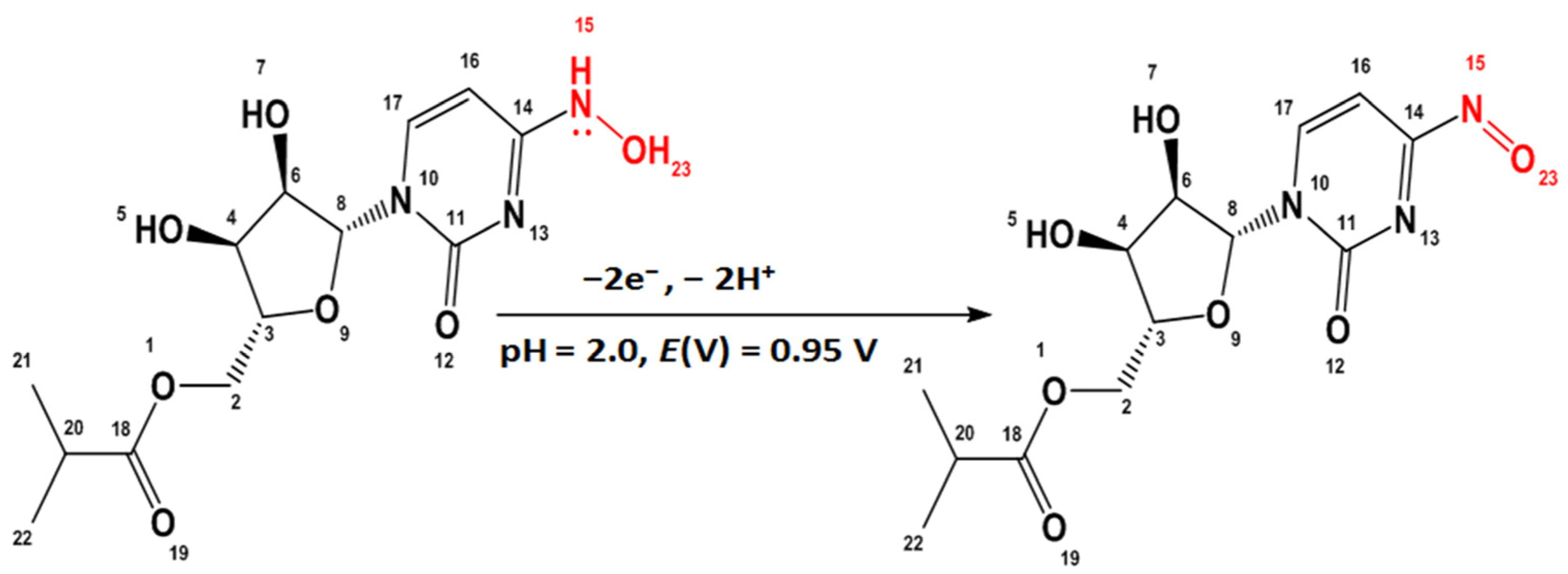
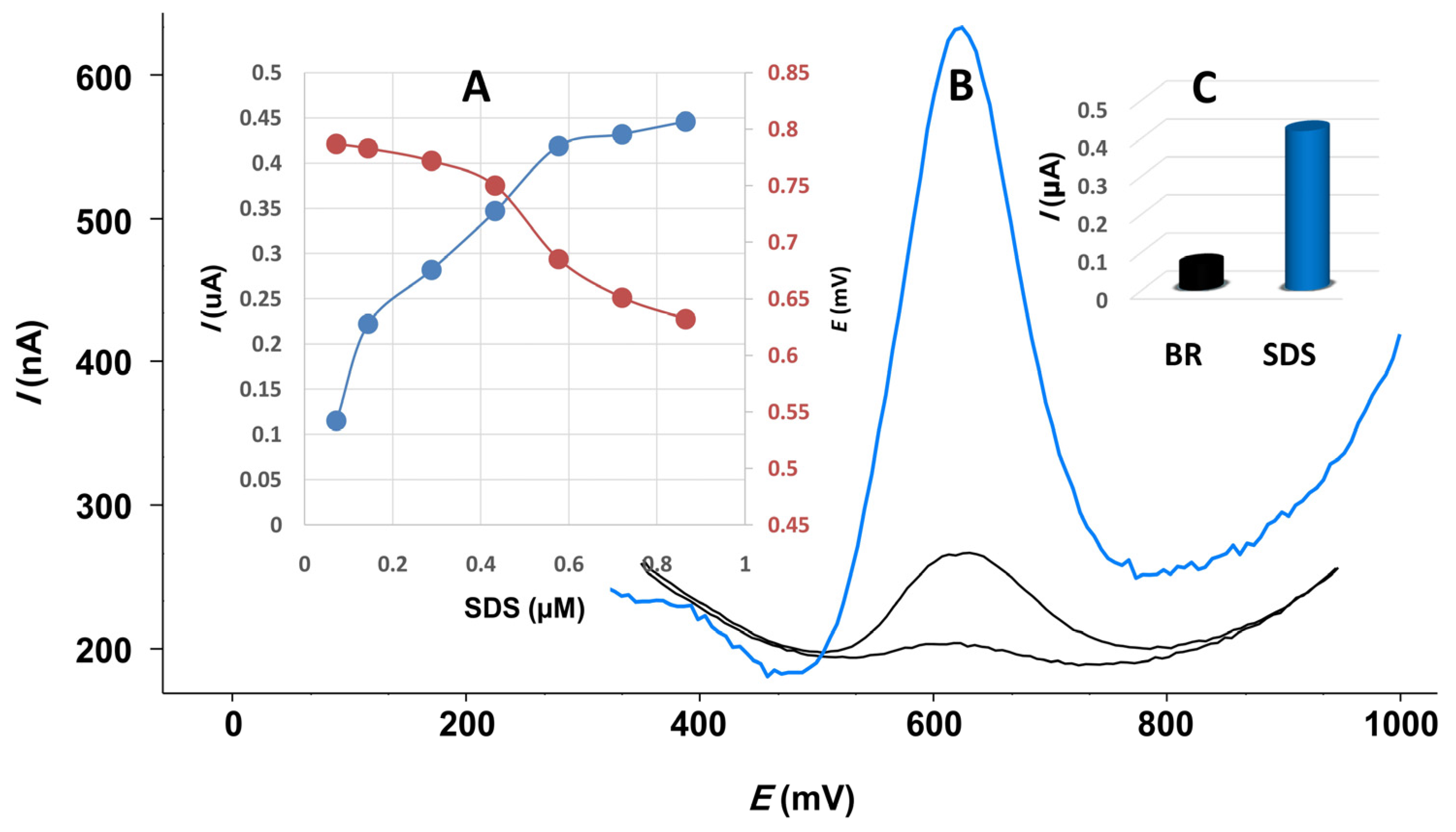
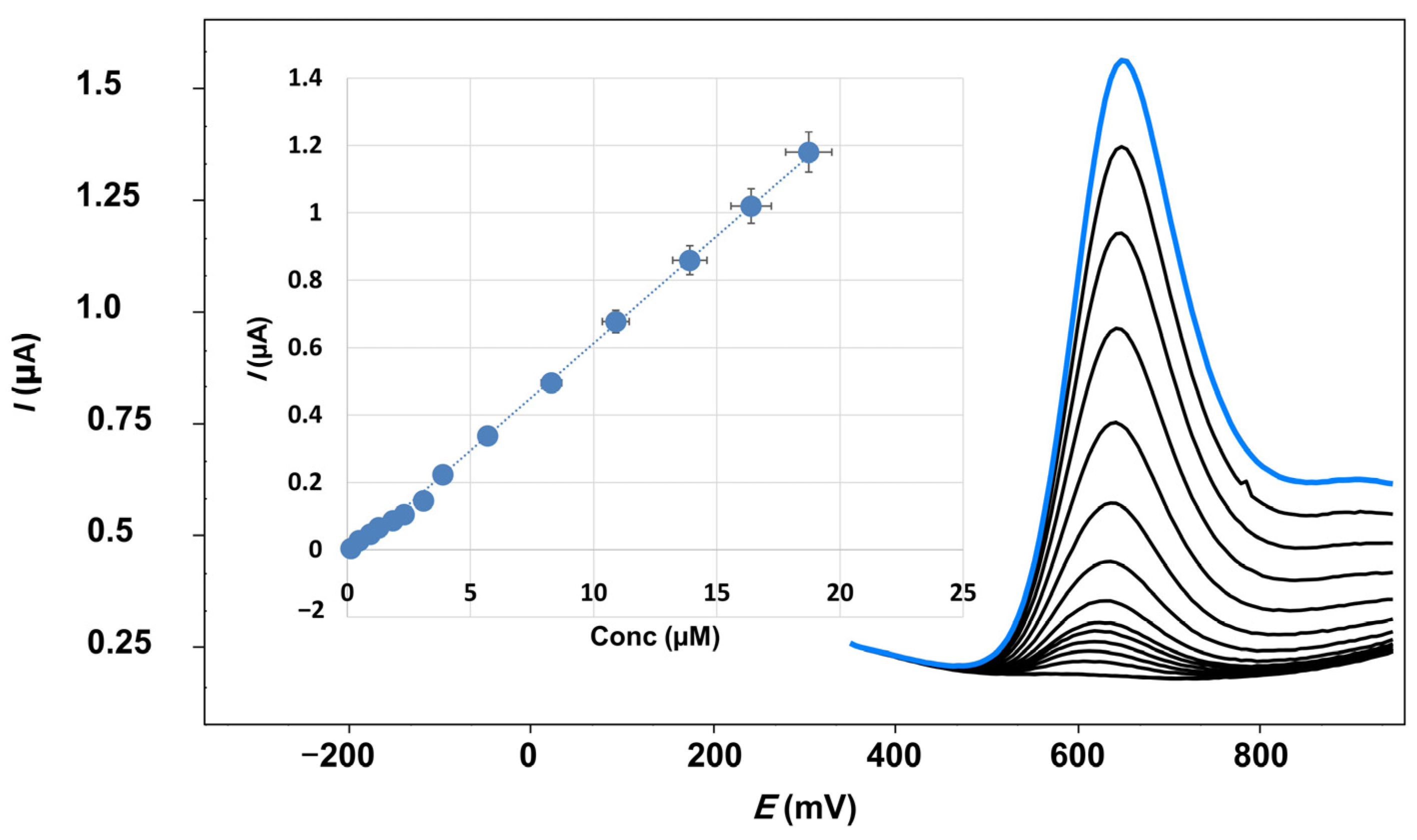
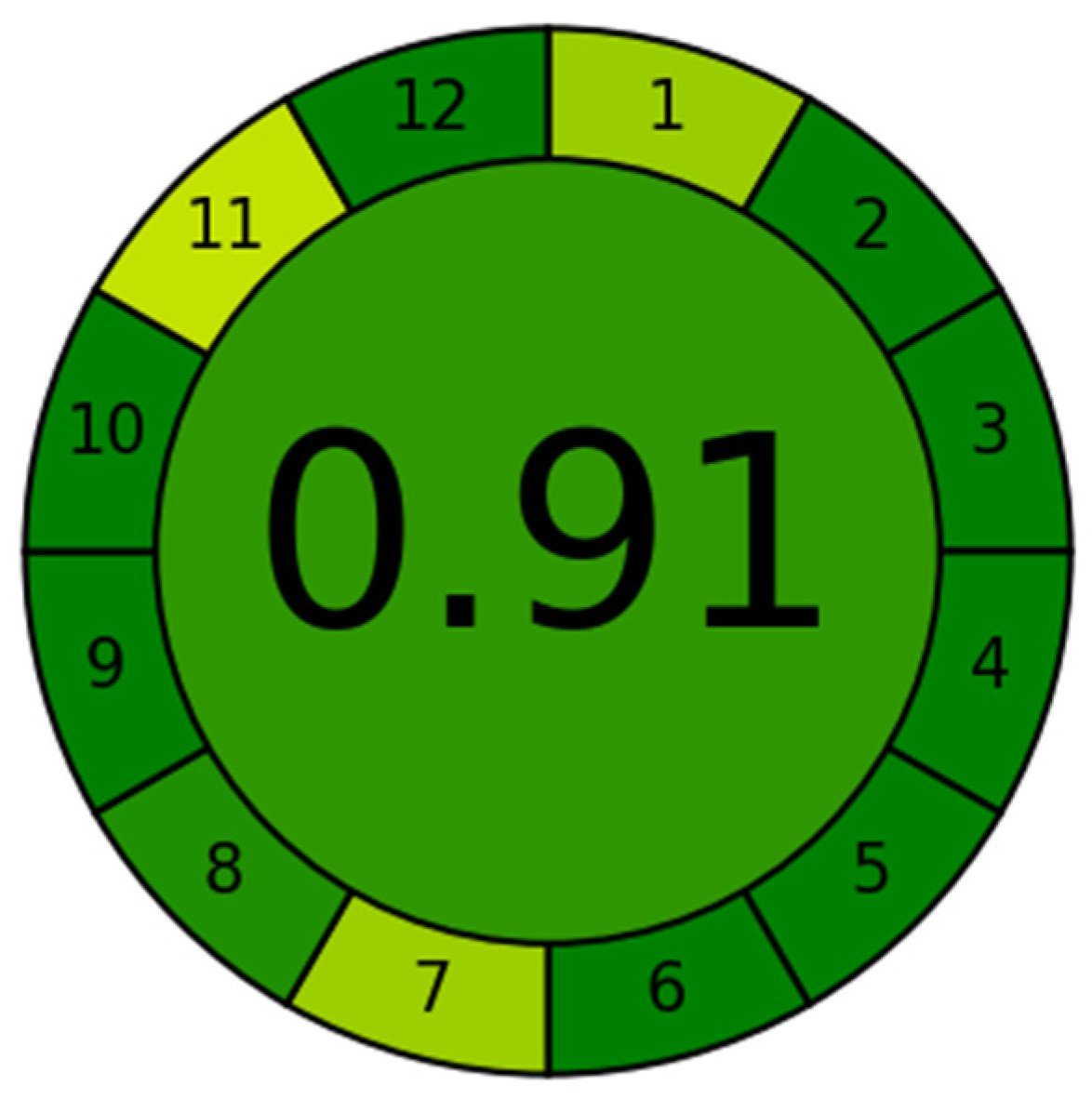
| Electrode | ΔE (mV) | Ipa/Ipc (µA) | Active Area (cm2) |
|---|---|---|---|
| CPE | 0.089 | 0.86 | 0.035 |
| MWCNT-modified CPE | 0.089 | 0.833 | 0.061 |
| rGO-SPCE (0.5%) | 0.089 | 0.765 | 0.055 |
| rGO-SPCE (1.5%) | 0.09 | 0.925 | 0.076 |
| rGO-SPCE (2.5%) | 0.083 | 0.992 | 0.083 |
| rGO-SPCE (4.0%) | 0.081 | 0.862 | 0.086 |
| Parameters | MOV |
|---|---|
| E (mV) | 641 |
| pH | 2 |
| Linearity range (µM) | 0.152–18.272 |
| Intercept | −0.0238 |
| Slope | 0.0002 |
| Multiple R | 0.9994 |
| R square | 0.9989 |
| Standard Error | 0.01 |
| RSD | 1.43 |
| LOD (µM) | 0.048 |
| LOQ (µM) | 0.147 |
| Intra-day precision of the peak current (RSD %) | 0.86 |
| Inter-day precision of the peak current (RSD %) | 1.23 |
| Intra-day precision of the peak potential (RSD %) | 0.95 |
| Inter-day precision of the peak potential (RSD %) | 1.12 |
| MOV (Batch no. 2201112) | Added (µM) | Found (µM) | Bias (%) | Developed Method Recovery (%) * | Reported Method [38] Recovery (%) * |
|---|---|---|---|---|---|
| 0.455 | 0.449 | −1.33 | 98.67 | 100.12 | |
| 1.366 | 1.381 | 1.11 | 101.11 | 98.97 | |
| 2.429 | 2.459 | 1.26 | 101.24 | 100.18 | |
| 7.287 | 7.312 | 0.34 | 100.34 | 99.95 | |
| Mean | 100.34 | 99.80 | |||
| Variance | 1.408 | 0.319 | |||
| F test | 4.41 | ||||
| t test. | 0.81 | ||||
| F tabulated a | (9.28) | ||||
| t tabulated a | (2.45) | ||||
| MOV | Spiked (µM) | Found (µM) | Bias% | Recovery (%) | RSD (%) |
|---|---|---|---|---|---|
| Human urine | 0.759 | 0.765 | 0.79 | 100.80 | 0.84 |
| 2.733 | 2.754 | 0.77 | 100.77 | 1.05 | |
| 4.555 | 4.576 | 0.46 | 100.46 | 0.95 | |
| 6.225 | 6.210 | −0.24 | 99.75 | 1.11 | |
| Human serum | 1.154 | 1.160 | 0.52 | 100.52 | 1.24 |
| 2.277 | 2.256 | −0.92 | 99.08 | 0.98 | |
| 5.466 | 5.442 | −0.44 | 99.56 | 0.78 | |
| 7.592 | 7.561 | −0.41 | 99.59 | 1.33 |
Disclaimer/Publisher’s Note: The statements, opinions and data contained in all publications are solely those of the individual author(s) and contributor(s) and not of MDPI and/or the editor(s). MDPI and/or the editor(s) disclaim responsibility for any injury to people or property resulting from any ideas, methods, instructions or products referred to in the content. |
© 2023 by the authors. Licensee MDPI, Basel, Switzerland. This article is an open access article distributed under the terms and conditions of the Creative Commons Attribution (CC BY) license (https://creativecommons.org/licenses/by/4.0/).
Share and Cite
Nabil, A.; Hendawy, H.A.M.; Abdel-Salam, R.; Ahmed, R.M.; Shawky, A.; Emara, S.; Ibrahim, N. A Green Voltammetric Determination of Molnupiravir Using a Disposable Screen-Printed Reduced Graphene Oxide Electrode: Application for Pharmaceutical Dosage and Biological Fluid Forms. Chemosensors 2023, 11, 471. https://doi.org/10.3390/chemosensors11090471
Nabil A, Hendawy HAM, Abdel-Salam R, Ahmed RM, Shawky A, Emara S, Ibrahim N. A Green Voltammetric Determination of Molnupiravir Using a Disposable Screen-Printed Reduced Graphene Oxide Electrode: Application for Pharmaceutical Dosage and Biological Fluid Forms. Chemosensors. 2023; 11(9):471. https://doi.org/10.3390/chemosensors11090471
Chicago/Turabian StyleNabil, Abdelrahman, Hassan A. M. Hendawy, Randa Abdel-Salam, Rasha M. Ahmed, Ahmed Shawky, Samy Emara, and Noha Ibrahim. 2023. "A Green Voltammetric Determination of Molnupiravir Using a Disposable Screen-Printed Reduced Graphene Oxide Electrode: Application for Pharmaceutical Dosage and Biological Fluid Forms" Chemosensors 11, no. 9: 471. https://doi.org/10.3390/chemosensors11090471
APA StyleNabil, A., Hendawy, H. A. M., Abdel-Salam, R., Ahmed, R. M., Shawky, A., Emara, S., & Ibrahim, N. (2023). A Green Voltammetric Determination of Molnupiravir Using a Disposable Screen-Printed Reduced Graphene Oxide Electrode: Application for Pharmaceutical Dosage and Biological Fluid Forms. Chemosensors, 11(9), 471. https://doi.org/10.3390/chemosensors11090471









